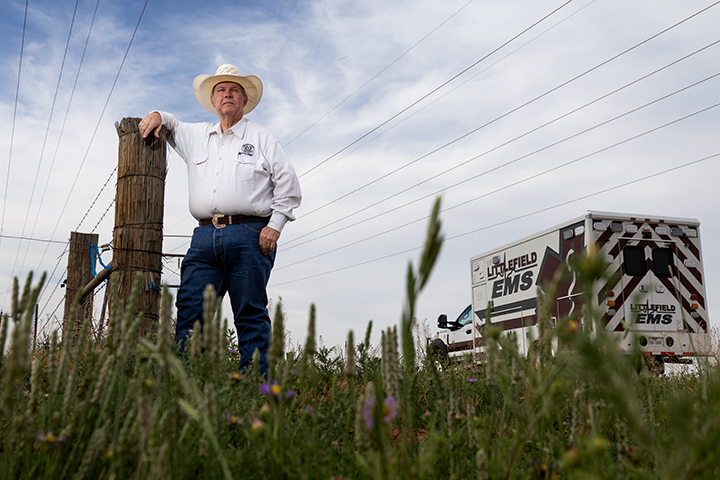County Magazine | June 25, 2025
Texas takes action on EMS
New state funds aim to address rural ambulance shortfall

Presidio County Judge Jose Portillo calls his border community the “poster child” for the problems facing rural emergency medical services in Texas.
Its southernmost city, Presidio, is 90 miles from the nearest hospital in Alpine and has one of only two ambulances that serve the county’s entire 4,000 square miles.
A round trip to the Alpine hospital can take as long as four hours, leaving the area effectively without emergency service in the meantime. Take into account that 2 million people cross the U.S.-Mexico border in the county each year, and more than 1 million people visit Big Bend Ranch State Park annually, the potential absence of timely medical care spells big trouble for anyone in need of an urgent response.
Portillo said the high mileage they put on their ambulances limits their usable lifespan to about a year. At a price tag of $400,000 for a new ambulance, Presidio County, with its $4 million annual budget, can’t bear the cost. Add in the price of a stretcher system, heart monitor, medications and other equipment, and that expense inches closer to $600,000.
Presidio County is far from alone. Many rural counties across West Texas, South Texas and the Panhandle are considered "ambulance deserts," with no access to a Level I or II trauma center within an hour's drive, and many have no hospital or EMS station. This situation endangers both residents and travelers. More than half of traffic fatalities in Texas occur on rural roads, and a four-hour round trip to a hospital can mean the difference between life and death.
“One call of a patient to Alpine means we are exposed,” Portillo said.
Help is on the way
A new state grant program, created through House Bill 3000 passed by the Texas Legislature during this year’s session, aims to improve rural EMS. It offers up to $500,000 to counties with populations under 10,000 and up to $350,000 to counties with populations between 10,000 and 68,750 to help purchase new ambulances.
The grant program is expected to begin in January. It will be administered by the Texas Comptroller’s Office. Private safety entities and public health agencies licensed by the Department of State Health Services operating in predominately rural areas will be eligible to receive funding directly through their county commissioners courts.
“This is a win for everyone, especially our first responders who answer those calls to an unsuspecting public that might not get the help they need otherwise without this very important bill passing,” said Johnson County Commissioner Rick Bailey, the legislative committee chairman for the County Judges and Commissioners Association of Texas, which helped drive the effort to get HB 3000 passed.
“Thanks to all that gave testimony and especially the legislators who answered the call. Texas will be safer for it,” he said.
Bailey, in his testimony at the Capitol during the session, emphasized the challenges facing his rapidly growing county south of Fort Worth. Its population has increased 17% since 2020.
Johnson County has a contract with the company CareFlite to operate five ambulances in the region at a cost of $1.5 million annually. When the county crafted its contract with CareFlite last year, it was based on an average of 20 calls a day. Johnson County has continued to grow at a record clip since then, now with an average of 35 calls a day.
“With a growing population, on top of the extended daily call log, we know this is going to come at a tremendous cost to our taxpayers,” Bailey said.
Complicating factors in Johnson County have been the loss of both the maternity and cardiac wings of its sole hospital in Cleburne. This means they’ve had to transport people farther away to other hospitals for this care, which leads to longer response times.
Hospitals across the state are continuing to lose medical services because of a host of issues including population loss, greater numbers of uninsured residents, aging infrastructure, and cuts in Medicaid and Medicare reimbursement. According to the Texas Hospital Association, 21 rural hospitals have closed during the past decade, and 26% more are in danger of closing.
Other legislation passed this session seeks to address this problem. House Bill 18, known as the Rural Health Stabilization and Innovation Act, will help rural hospitals apply for state and federal health care financing. It also creates four new grant programs to assist hospitals that will be awarded based on financial risk, disaster recovery needs and innovative care initiatives.
“Our EMS services are the only medical care in the county. There is no clinic, no hospitals, no doctors. We are losing them,” Lamb County Judge James M. DeLoach said. “If you have a wreck or get sick on the road in some counties, there is no one to take care of you. You may wait an hour for someone.”
More work ahead
DeLoach has been certified as an EMT since the 1980s. Over the decades, he has seen prices skyrocket for ambulances and supplies. A heart monitor that was $500 when he started his career now costs $50,000.
“Today, the standard of care has increased, and we are expected to deliver the same level of care in the rural areas as the urban areas,” DeLoach said. “And we should.”
Lamb County relies mostly on volunteer fire departments to cover its 1,000 square miles. These departments survive largely on donations, and it’s not enough anymore to cover the cost of ambulances.
“The days of having bake sales and barbecues to raise money to keep these things on the road are gone,” said Rick Thompson, program director for the County Judges and Commissioners Association.
Thompson said hiring personnel to staff ambulances remains the most inhibiting factor for service — paramedics typically move to larger cities where they can earn a higher salary. The money provided by the Legislature will not cover the cost for personnel, though county officials are hopeful to receive additional funding in the future. Additionally, ambulance manufacturers can often take up to three years to complete delivery, so it could be some time before conditions fully improve.
For now, the grant program is a good start to help address service challenges. Counties that would have paid hundreds of thousands of dollars for a new ambulance can now put that money toward EMS salaries.
“It helps because it allows us to use those funds that otherwise would have been spent on ambulances to divert back to other shortcomings we have,” Portillo said. “Presidio has no money in the bank. We spend every nickel we collect. We make it to the end of the fiscal year on fumes.”
Looking ahead, the number of Texans aged 65 and older is expected to more than double by 2050, which means the demand for emergency medical services will only increase. Mobile EMS units are already offering some longer-term solutions for areas without ambulance departments and hospitals, but these, too, come at a steep cost.
The County Judges and Commissioners Association, along with the Texas Organization of Rural & Community Hospitals and the Texas EMS Alliance, plans to seek federal funding to further help address the problem.
“This funding from the Texas Legislature is certainly a foundation we can build on,” DeLoach said. “In the time I’ve been in EMS in my career, right around 40 years, we have never had this type of participation by the state Legislature. We have them at the table. We need to build on that relationship and continue to work with them. They are trying to find a way to help.”

